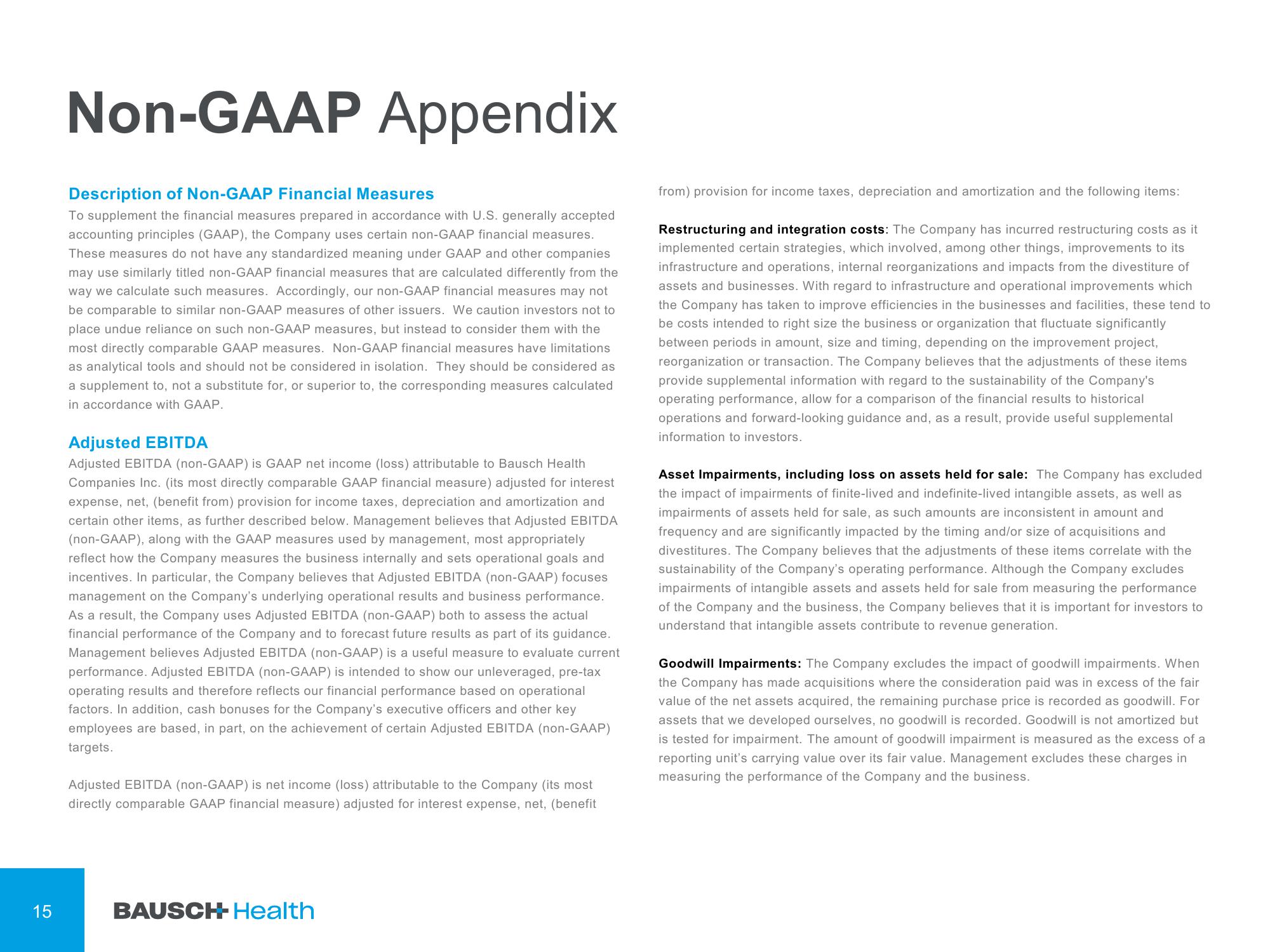Bausch Health Companies Shareholder Engagement Presentation Deck
15
Non-GAAP Appendix
Description of Non-GAAP Financial Measures
To supplement the financial measures prepared in accordance with U.S. generally accepted
accounting principles (GAAP), the Company uses certain non-GAAP financial measures.
These measures do not have any standardized meaning under GAAP and other companies
may use similarly titled non-GAAP financial measures that are calculated differently from the
way we calculate such measures. Accordingly, our non-GAAP financial measures may not
be comparable to similar non-GAAP measures of other issuers. We caution investors not to
place undue reliance on such non-GAAP measures, but instead to consider them with the
most directly comparable GAAP measures. Non-GAAP financial measures have limitations
as analytical tools and should not be considered in isolation. They should be considered as
a supplement to, not a substitute for, or superior to, the corresponding measures calculated
in accordance with GAAP.
Adjusted EBITDA
Adjusted EBITDA (non-GAAP) is GAAP net income (loss) attributable to Bausch Health
Companies Inc. (its most directly comparable GAAP financial measure) adjusted for interest
expense, net, (benefit from) provision for income taxes, depreciation and amortization and
certain other items, as further described below. Management believes that Adjusted EBITDA
(non-GAAP), along with the GAAP measures used by management, most appropriately
reflect how the Company measures the business internally and sets operational goals and
incentives. In particular, the Company believes that Adjusted EBITDA (non-GAAP) focuses
management on the Company's underlying operational results and business performance.
As a result, the Company uses Adjusted EBITDA (non-GAAP) both to assess the actual
financial performance of the Company and to forecast future results as part of its guidance.
Management believes Adjusted EBITDA (non-GAAP) is a useful measure to evaluate current
performance. Adjusted EBITDA (non-GAAP) is intended to show our unleveraged, pre-tax
operating results and therefore reflects our financial performance based on operational
factors. In addition, cash bonuses for the Company's executive officers and other key
employees are based, in part, on the achievement of certain Adjusted EBITDA (non-GAAP)
targets.
Adjusted EBITDA (non-GAAP) is net income (loss) attributable to the Company (its most
directly comparable GAAP financial measure) adjusted for interest expense, net, (benefit
BAUSCH- Health
from) provision for income taxes, depreciation and amortization and the following items:
Restructuring and integration costs: The Company has incurred restructuring costs as it
implemented certain strategies, which involved, among other things, improvements to its
infrastructure and operations, internal reorganizations and impacts from the divestiture of
assets and businesses. With regard to infrastructure and operational improvements which
the Company has taken to improve efficiencies in the businesses and facilities, these tend to
be costs intended to right size the business or organization that fluctuate significantly
between periods in amount, size and timing, depending on the improvement project,
reorganization or transaction. The Company believes that the adjustments of these items
provide supplemental information with regard to the sustainability of the Company's
operating performance, allow for a comparison of the financial results to historical
operations and forward-looking guidance and, as a result, provide useful supplemental
information to investors.
Asset Impairments, including loss on assets held for sale: The Company has excluded
the impact of impairments of finite-lived and indefinite-lived intangible assets, as well as
impairments of assets held for sale, as such amounts are inconsistent in amount and
frequency and are significantly impacted by the timing and/or size of acquisitions and
divestitures. The Company believes that the adjustments of these items correlate with the
sustainability of the Company's operating performance. Although the Company excludes
impairments of intangible assets and assets held for sale from measuring the performance
of the Company and the business, the Company believes that it is important for investors to
understand that intangible assets contribute to revenue generation.
Goodwill Impairments: The Company excludes the impact of goodwill impairments. When
the Company has made acquisitions where the consideration paid was in excess of the fair
value of the net assets acquired, the remaining purchase price is recorded as goodwill. For
assets that we developed ourselves, no goodwill is recorded. Goodwill is not amortized but
is tested for impairment. The amount of goodwill impairment is measured as the excess of a
reporting unit's carrying value over its fair value. Management excludes these charges in
measuring the performance of the Company and the business.View entire presentation